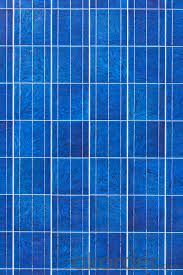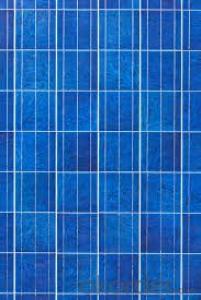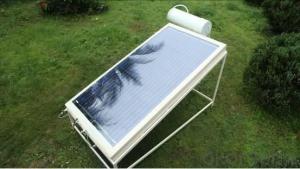Mini 0.45W Poly solar Panel with 25 Years Warranty CNBM
- Loading Port:
- Qingdao
- Payment Terms:
- TT OR LC
- Min Order Qty:
- 10 set
- Supply Capability:
- 300000 set/month
OKorder Service Pledge
OKorder Financial Service
You Might Also Like
Polycrystalline Solar Modules
CNBM offers a range of small, medium and large polycrystalline solar modules, designed for a range of requirements.


Specifications:
Tolerance | +/-3% |
Cell | Polycrystalline silicon solar cells (156 x 156mm) |
N0. of Cells | 60 (10 x 6) |
Dimension of Modules (mm) | 1650 x 990 x 40 |
Weight (kg) | 25.5 |
Limits:
Operating Temperature | -40~+85? |
Storage Temperature | -40~+85? |
Maximum System Voltage | 1000 VDC max. |
Hail Impact | Diameter of 28mm with impact speed |
Temperature and Coefficients:
NOCT | 48C+/-2? |
Voltage temperature coefficient (%/K) | -0.35 |
Current temperature coefficient (%/K) | 0.05 |
Power temperature coefficient (%/K) | -0.45 |
Characteristics:
Model: | SGM-200P | SGM-210P | SGM-220P |
Max-power voltage Vmp (V) | 29.2 | 29.4 | 29.41 |
Max-power current Imp (A) | 6.85 | 7.14 | 7.48 |
Open-circuit voltage Voc (V) | 36.5 | 36.69 | 36.9 |
Short-Circuit Current Isc (A) | 7.28 | 7.6 | 7.93 |
Max-power Pm(W) | 200 | 210 | 220 |
Model: | SGM-230P |
Max-power voltage Vmp (V) | 29.8 |
Max-power current Imp (A) | 7.72 |
Open-circuit voltage Voc (V) | 37.31 |
Short-Circuit Current Isc (A) | 8.19 |
Max-power Pm(W) | 230 |
STC: Irradiance 1000W/m2, module temperature 25?, AM-=1.5
Poly Crystalline Solar Panels Specifications Range
Maximum Power (Pm) | Dimension | Weight | Operating Voltage (Vmp) | Operating Current (Imp) | Open Circuit Voltage (Voc) | Short Circuit Current (Isc) |
0.45W | 140x80x10mm | 0.08kg | 3.3V | 150mA | 4.6V | 160mA |
1.0W | 162x140x10mm | 0.16kg | 7.5V | 150mA | 10.3V | 160mA |
4.5W | 269x251x23mm | 0.8kg | 16.5V | 0.27A | 20.5V | 0.3A |
10W | 420.1×268.9×22.6mm | 1.92kg | 17.5V | 0.58A | 20.5V | 0.6A |
20W | 425x502x50mm | 3.0kg | 16.8V | 1.19A | 21.0V | 1.29A |
30W | 593x502x22.6mm | 3.9kg | 16.8V | 1.78A | 21.0V | 1.94A |
40W | 655x537x50mm | 5.75kg | 17.3V | 2.31A | 22.1V | 2.54A |
50W | 839x537x50mm | 6.0kg | 17.5V | 2.9A | 21.8V | 3.17A |
65W | 1111x502x50mm | 7.2kg | 17.6V | 3.69A | 22.1V | 3.99A |
80W | 1204x537x50mm | 7.7kg | 17.6V | 4.55A | 22.1V | 4.8A |
- Q:What is the impact of dust or dirt on solar cell performance?
- The presence of dust or dirt on solar cells can significantly impact their performance. As these particles accumulate on the surface of the cells, they create a barrier that reduces the amount of sunlight reaching the photovoltaic material. This obstruction leads to a decrease in the conversion of solar energy into electricity, resulting in a lower overall efficiency of the solar panels. Regular cleaning and maintenance are essential to ensure optimal performance and maximize the electricity generation from solar cells.
- Q:Can solar cells be used in electric fences?
- Yes, solar cells can be used in electric fences. Solar cells can convert sunlight into electricity, which can power the electric fence energizer. This eliminates the need for a constant power supply or batteries, making it a sustainable and cost-effective option for powering electric fences.
- Q:Can solar cells be used in underwater applications?
- Yes, solar cells can be used in underwater applications. However, special considerations need to be taken, such as using waterproof and corrosion-resistant materials, optimizing the design for low light conditions, and addressing the challenges of transmitting power and data underwater.
- Q:What is the lifespan of a solar cell battery?
- The lifespan of a solar cell battery can vary depending on various factors such as the quality of the battery, usage patterns, and maintenance. On average, a well-maintained solar cell battery can last anywhere between 5 to 20 years.
- Q:Can solar cells be used for refrigeration?
- Yes, solar cells can be used for refrigeration. Solar-powered refrigeration systems utilize solar cells to convert sunlight into electricity, which is then used to power the refrigeration process. This technology is particularly useful in off-grid or remote areas where access to electricity is limited. It allows for sustainable and environmentally-friendly refrigeration solutions.
- Q:What is the impact of algae growth on solar cell performance?
- The impact of algae growth on solar cell performance is generally negative. Algae growth can block sunlight from reaching the solar cells, reducing their efficiency and energy output. Additionally, algae can cause corrosion and damage to the surface of solar panels, further compromising their performance. Regular cleaning and maintenance are necessary to prevent algae buildup and ensure optimal solar cell performance.
- Q:How do solar cells perform in regions with high levels of dust and sandstorms?
- Solar cells can be affected by high levels of dust and sandstorms in regions. The accumulation of dust particles on the surface of solar panels can reduce their efficiency by blocking sunlight and reducing the amount of energy they can generate. Regular cleaning and maintenance are crucial in these areas to ensure optimal performance of solar cells and to prevent any long-term damage caused by the accumulation of dust and sand.
- Q:Can the 156x156mm high efficiency single crystal cells assembly function better compared to the traditional one?
- The media already commented a lot on the 156x156mm high efficiency single crystal cells assembly, which make me wonderabout its real function.
- Q:What is the solar cell?
- The type of solar cells can be divided according to the materials used: silicon solar cells, solar cells and organic semiconductor system of solar cells.
- Q:How do solar cells impact energy consumption patterns?
- Solar cells have a significant impact on energy consumption patterns by providing a source of clean and renewable energy. They reduce the reliance on fossil fuels and contribute to a more sustainable and environmentally friendly energy production and consumption.
1. Manufacturer Overview |
|
|---|---|
| Location | |
| Year Established | |
| Annual Output Value | |
| Main Markets | |
| Company Certifications | |
2. Manufacturer Certificates |
|
|---|---|
| a) Certification Name | |
| Range | |
| Reference | |
| Validity Period | |
3. Manufacturer Capability |
|
|---|---|
| a)Trade Capacity | |
| Nearest Port | |
| Export Percentage | |
| No.of Employees in Trade Department | |
| Language Spoken: | |
| b)Factory Information | |
| Factory Size: | |
| No. of Production Lines | |
| Contract Manufacturing | |
| Product Price Range | |
Send your message to us
Mini 0.45W Poly solar Panel with 25 Years Warranty CNBM
- Loading Port:
- Qingdao
- Payment Terms:
- TT OR LC
- Min Order Qty:
- 10 set
- Supply Capability:
- 300000 set/month
OKorder Service Pledge
OKorder Financial Service
Similar products
New products
Hot products
Hot Searches
Related keywords





























